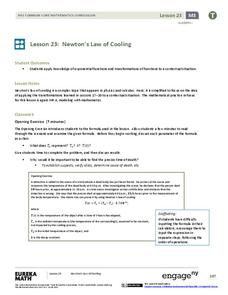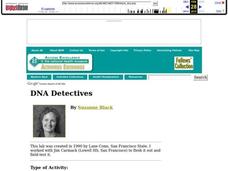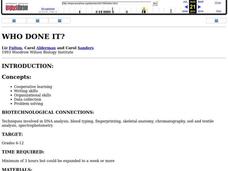Radford University
The Pythagorean Theorem in Crime Scene Investigation
It's a Pythagorean who-dun-it. Pupils apply the Pythagorean Theorem in several different real-world scenarios involving right triangles. By solving each task, they find the thief who was responsible for a museum heist.
Curated OER
CSI Podcasts
Students investigate crime scene scenarios to meet standards. In this crime scene scenario lesson, students gather background information during the first week. They investigate topics such as mammals, genetics, bacteria, or fungi. They...
Curated OER
Who Done It?
Pick and choose which activities to include in this crime scene investigation. Junior detectives can examine fingerprints, DNA, blood samples, or bone structure. The plan suggests you have teams solve a mystery, but it does not give you...
Curated OER
Blood Typing Investigation
Students role-play a scenario in which a car crash patient is inadvertently given the wrong blood type during a transfusion. They perform blood typing and explore the genetics behind ABO and RH blood types using simulated blood.
EngageNY
Newton’s Law of Cooling
As part of an investigation of transformations of exponential functions, class members use Newton's Law of Cooling as an exponential model to determine temperature based on varying aspects. The resource makes comparisons between models...
Curated OER
Cardiac Arrest! Using Forensics to Investigate Cardiovascular Anatomy and Function
Students identify the different parts and functions of the cardiovascular system. In this forensics lesson, students collect and analyze evidence on a fictional crime. They describe different causes of cardiac arrest.
Curated OER
DNA Detectives
In order to understand DNA fingerprinting, advanced biology aces divise a crime scenario and analyze three different samples of lambda DNA. This creative lesson plan provides practice with micropipettes, electrophoresis boxes, and other...
Curated OER
My Science Box: DNA Fingerprinting
Young scholars identify DNA in a crime scenario. In this DNA lesson, students perform paper chromatography and compare it against the pens of various suspects.
Curated OER
Interdisciplinary Applications of Chemistry Through Engineering in Modern Medicine
Students explore the different techniques used in forensic science. In this chemistry lesson, students investigate a fictional crime and identify the culprit. They create a brochure or collage career bulletin.
Curated OER
Who Done It?
Students work in groups to solve various murder mysteries using DNA evidence to implicate suspects. Teams compete to solve the crimes the fastest, while using various scientific methods to accomplish their task.
Curated OER
Criminal Activities
Students investigate Justice Week in Britain. In this current events lesson plan, students visit selected websites related to law and order in the U.K. Students may create their own anti-social art as a culminating activity.
Curated OER
Who's Who and How Do You Know for Sure?
Students investigate the applications of DNA fingerprinting, They read crime scenarios and using the details of the crime and laboratory experimentation decide the suspects guilt or innocence.
Curated OER
The Animals vs. Napoleon
In this literature analysis worksheet, students read Animal Farm and complete a trial activity project based on the characters of the animals vs. Napoleon.














